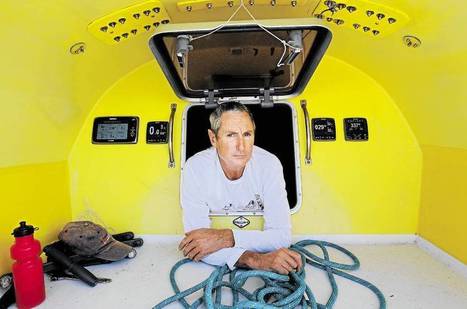 Your new post is loading...
 Your new post is loading...
Copper telecommunications networks used for delivering DSL broadband to most homes today in Australia and around the world are capable of faster internet speeds than they are now, but only if the networking community gets working on speeding them up.
That is the view of Patrick Lo, the global chairman and chief executive of home networking giant Netgear. Speaking to Fairfax Media while on a visit to Australia last week, San Jose-based Mr Lo said he believed the networking and research community was likely to find even better ways to deliver broadband via copper at much faster speeds than are achievable today.
Mr Loh's comments come after opposition communications spokesman Malcolm Turnbull recently leapt upon a new technology standard that networking vendors say will deliver 1 Gbps speeds over copper. The technology, called G.fast, uses a combination of DSL technologies to produce maximum 1 Gbps speeds over short distances of copper that are between 100 metres and 200 metres long. The International Telecommunications Union is moving towards making the technology a DSL standard by March 2014.
"Even though today you could argue that copper has a limitation in speed – maybe up to 100 Mbps into the house – there's the possibility going forward that we [the networking community] will make the copper even more efficient," Mr Lo said.
"... We don't know [how fast] because as long as the copper is not broken people will still find ways to squeeze more transmission into the copper."
Click headline to read more and watch video of interview--
Remember the Hydrogen Highway?
It was front-page news less than a decade ago, and the California Fuel Cell Partnership in West Sacramento was ground zero for what was touted as a forward-looking effort to green the Golden State.
Approved in 2004 by then-Gov. Arnold Schwarzenegger, who promoted it with action film hero gusto, the Hydrogen Highway envisioned construction of an extensive network of hydrogen filling stations to serve drivers of zero-emission fuel-cell vehicles – bettering California’s air quality, enhancing the Golden State’s reputation as a leader in national environmental policy and lessening U.S. dependence on foreign oil.
Hydrogen has long been viewed by advocates and environmentalists as an attractive option, because it can easily be pumped into a vehicle tank, with the bonus of no emissions of either greenhouse gases or smog-forming pollutants. In a fuel-cell vehicle, hydrogen combines with oxygen, yielding a current that drives an electric motor. The tailpipe spews nothing but water vapor and heat.
Supporters add that hydrogen can be produced in abundance by American companies. Environmentalists simply say that it’s not oil, with all its pollution and price-volatility baggage.
Critics noted then and now that much hydrogen is processed from natural gas and that alternative methods are costly. That did not deter Schwarzenegger, who was a welcome visitor at the fuel cell partnership headquarters. President George W. Bush also dropped by for a visit in 2006, talking up hydrogen technology.
Today, the high-flying promise of those days remains unfulfilled.
Click headline to read more--
The Telegraph understands that up to 60 Conservatives are likely oppose the plans in the Commons, while “scores” of back-benchers are to launch a formal group to campaign for an end to the scheme.
Senior Tories fear that the Coalition’s £50 billion flagship infrastructure project represents “an unutterable waste of money” and that there is no credible business case for proceeding.
The Conservative campaign against the new line is being stepped up ahead of a Commons vote on the legislation preparing the way for the development, expected later this month.
It comes as it emerged that Nigel Farage, leader of the UK Independence Party, is to share a stage with a senior Tory to call for the project to be abandoned.
Ukip is the only political party currently arguing for the planned line from London to the North to be axed but the party is seen as “the enemy” by high-ranking Tories.
Click headline to read more--
Scientists have known for centuries that mangroves are one of the most carbon-rich ecosystems on Earth. Now that knowledge has been refined with the development of a map and model that pinpoint just how much carbon is stored in different mangrove areas around the world.
The discovery, published in Conservation Letters, will be of practical use because understanding this variability is critically important in developing policies and setting priorities to safeguard the carbon stores, and possibly expanding them.
The new model used by the researchers enabled them to map the variations among the world’s mangrove forests and pinpoint those areas with the most carbon.
All mangroves are important for storing carbon, but some that ranked particularly high in the study include forests in Sumatra, Borneo and New Guinea, on the Pacific coast of Colombia, and in Northern Ecuador.
Mark Spalding, principal investigator on the project and a marine scientist at the US-based worldwide conservation organisation The Nature Conservancy, says: “These results can help guide decisions regarding priority areas for the conservation and rehabilitation of mangroves for climate change mitigation.”
Click headline to read more--
If seriousness and commitment on the part of Nawaz Sharif government is to be adjudged it should be done, inter alia, on the yardstick of achievements of Ministry of Information Technology and Telecom under the inspiring leadership of Ms. Anusha Rehman, the Minister of State for IT & Telecom. In fact, all these achievements owe primarily to the vision of Prime Minister Nawaz Sharif who views information technology as one of the most important channels of empowerment of the nation, particularly the younger generation. And, secondly, it owes to the dynamic Minister of State Anusha Rehman’s energetic input. According to people who have watched her working in office and in the field, the lady minister is an ardent believer in revolutionising the entire education and technology sector through the introduction of most modern IT tools in Pakistan. As declared herself by Ms Rehman, “The vision of our government is to promote universal access and universal service to telecommunications and information services as an empowerment vehicle for disadvantaged communities.” This vision itself is a big driving force behind IT minister’s mission of underprivileged communities’ empowerment. Hitherto, there has been much talk about expansion and diversification of IT sector and some steps had also been taken in this direction during the tenures of previous governments. But one thing was lacking in the previous regimes’ planning and that was focus on the less-privileged classes. But, now the entire focus has been redirected towards the disadvantaged communities (to quote the minister) and there is good news in this context for the rural folk who have been having a minimal share in the past in IT advancement plans and projects. This inadequacy has been well addressed now since the rural areas of Pakistan would soon be getting Telecenters that the IT Ministry and Universal Service Fund Company (USF) are jointly establishing in Pakistani villages through USF.
Click headline to read more--
In follow up to my earlier post, here are a couple of additional points.
1) A related but different argument petitioners are making about why the PSD provisions don't apply to the regulation of greenhouse gases is that the application of the provisions would lead to absurd results. The absurd results come about because the definition of "major source" in the PSD statutory language -- 100 tons per year of any air pollutant -- would sweep in a huge number of small sources that Congress never intended to regulate. In order to avoid absurd results, the Court should find that the plain language of the PSD provisions doesn't apply. Stanford Law Professor Michael Wara asked me about this argument in the comments section of my last post.
As I responded to Michael, I don't buy the absurd results argument. Here's why.
Click headline to read more--
Current wireless networks have a problem: The more popular they become, the slower they are. Researchers at Fudan University in Shanghai have just become the latest to demonstrate a technology that transmits data as light instead of radio waves, which gets around the congestion issue and could be 10 times faster than traditional Wi-Fi.
In dense urban areas, the range within which Wi-Fi signals are transmitted is increasingly crowded with noise — mostly, other Wi-Fi signals. What’s more, the physics of electromagnetic waves sets an upper limit to the bandwidth of traditional Wi-Fi. The short version: you can only transmit so much data at a given frequency. The lower the frequency of the wave, the less it can transmit.
But what if you could transmit data using waves of much higher frequencies and without needing a spectrum license from your country’s telecoms regulator?
Light, like radio, is an electromagnetic wave, but it has about 100,000 times the frequency of a Wi-Fi signal
Light, like radio, is an electromagnetic wave, but it has about 100,000 times the frequency of a Wi-Fi signal, and nobody needs a license to make a light bulb. All you need is a way to make its brightness flicker very rapidly and accurately so it can carry a signal.
The idea sounds daft: Who would want to sit under a flickering bulb? But Li-Fi, a standard proposed just two years ago, is seeing rapid technological progress.
Click headline to read more--
New research from Boston’s Northeastern University shows that with the shutdown of Megaupload, the U.S. Government took down at least 10.75 million legitimate files. The researchers examined the percentage of legal and copyright-infringing content on six file-hosting services. While infringing content outnumbers legitimate files on all sites, the volume of non-infringing content casts doubt on the drastic seizure that took place early last year.
When the U.S. Government took down Megaupload it branded the company as a pirate site with seemingly few legitimate uses. Up until now, however, there has been no research to back up this claim.
In an attempt to fill this gap researchers from Boston’s Northeastern University, together with colleagues from France and Australia, examined millions of files that were uploaded to five cyberlockers (FileFactory, Easy-share, Filesonic, Wupload and Megaupload) and the reupload service Undeadlink.
To find out whether the files were legitimate or not, the researchers extracted metadata from the site’s uploads using a link checker. The researchers controlled for several factors including split archives, and then manually determined the legitimacy of the files based on random samples of 1,000 uploads per site.
The results just published in the article titled “Holiday Pictures or Blockbuster Movies? Insights into Copyright Infringement in User Uploads to One-Click File Hosters” provide a unique insight into the proportion of infringing content on these services.
The main results displayed in the figure below reveal that the percentage of infringing files varies heavily between the six services. In addition, it also shows that for the majority of the files the researchers couldn’t conclusively determine whether a file was infringing or not.
Click headline to read more--
The ITU and UNESCO Broadband Commission for Digital Development has published a report on the state of broadband access across the globe that features the latest country-by-country data on state of broadband access worldwide.
The report came out in 21 September 2013 at the Broadband Commission’s 8th meeting in New York.
The Broadband Commission for Digital Development was set up by ITU and UNESCO in May 2010. The Commission is trying to raise the importance of broadband at the international level in the belief that expanding broadband access is crucial in order to accelerate progress. In cooperation with the private sector, the Commission outlines the practical methods in which countries can realize said progress.
Click headline to read more and watch video clips of the event--
Click the headline to watch this pre BBWF 2013 video with James Bagley, the Head of Strategy and Planning at BSkyB, full screen on the broadcaster’s vision for the connected home, and its strategy for fibre broadband.
AT&T has scored a deal to bring connectivity to the car of the future.
Chris Penrose, senior vice president of emerging technologies for the carrier, announced at GigaOM Mobilize 2013 Thursday that the wireless giant will be available inside Tesla’s advanced connected cars. The company’s wireless network will power the car’s two-way vehicle communications, remote engine diagnostics, and infotainment features.
“We believe that our ability to bring total solutions into the space is something that is being demanded, and something that we can excel and differentiate. Not just being a connectivity partner,” Penrose said onstage.
In order to take advantage of AT&T’s offerings, the vehicles must be equipped with a modem and a corresponding SIM card to connect to cell towers. With the connection, the car can take advantage of several maintenance, entertainment and safety features. For example, remote engine diagnostics can keep real-time tabs on how the Tesla is performing, and whether it needs to be taken in for servicing. That same program can also help locate a car if it’s stolen, and even offer Tesla engineers access to data on the performance of vehicles over the long term. The modem provides internet access to provide radio services, live weather and traffic, navigation and even internet search for drivers and passengers.
“We think that you should have the ability to turn your car on as a mobile hotspot for your trip, even if you haven’t subscribed to a data plan,” Penrose added.
Click headline to read more--
Thanks to this year's NSA revelations, the world wants to break up with the United States’ internet. The only problem? It's not sure how to.
Last week, global Internet organizations met in Uruguay—which so happens to be leading South America in Internet penetration—and pledged to untangle themselves from North American influence. While they didn’t come right out and explicitly name Snowden and his leaks about the NSA’s surveillance program, or even the United states, their released statement “expressed strong concern over the undermining of the trust and confidence of Internet users globally due to recent revelations of pervasive monitoring and surveillance.”
Naturally, that's referring to Snowden's leaks about NSA activities. Now, privacy concerns are already leading to a shift in the way the interenet operates. The US has traditionally been the world's leader in internet infrastructure, partly because it's been the center of innovation, and partly because, as TechCrunch wrote, our free speech laws “are perhaps the most ironclad of any."
It's become apparent that despite our free speech protections, the US internet is both heavily controlled—see the ongoing copyright battles—and surveilled. Domestically, those revelations are already having an impact. At least three secure email services have already shut down, and the eventual blowback to US tech companies in terms of lost business has been pegged at tens of billions of dollars.
Click headline to read more--
Algeria plans to set up innovation centres consisting of mixed research groups from higher education institutions, science and technology centres and the industrial, economic and social sectors, in an effort to boost the role of research in developing a knowledge-based economy.
The new initiative – one of the first steps in implementing a five-year (2013-17) higher education reform plan – was announced on 30 September by Mohamed Mebarki, the higher education and scientific research minister, according to El Khabar newspaper.
Funding for two years will be provided for innovation centres that will focus on translating university research into products and services.
The aim is for the innovation institutions, which will be spin-offs from universities, to help solve national problems, enhance research capacity and train high-level human resources for Algeria’s higher education sector.
Click headline to read more--
|
Three projects proposed for grants from the California Advanced Services Fund (CASF) have made it through the review process and are scheduled to be voted on by the California Public Utilities Commission next month. Two of the grant proposals were VDSL2-based and submitted by TDS Telecom, one for $1.8 million in the Olinda area of Shasta County and the other for $2.1 million in the Winterhaven area of Imperial County. Sebastian, which took over the Foresthill Telephone Company, is asking for $117,000 for a fixed wireless system upgrade in Placer County.
The draft resolutions were posted on the CPUC website earlier today, giving the minimum 30-day notice required before the scheduled vote by the commission on 3 October 2013. That date could change for any of the projects if one or more commissioners wants it delayed. But in the meantime, the public can comment on the grant proposals.
The requested funding ranges from $961 to $2,148 per household served. No one challenged the Foresthill project, although CPUC staff did ask Sebastian to run some mobile field tests to rule out possible conflicts. Verizon Wireless challenged the Olinda and Winterhaven projects, but didn’t submit any data to back up its complaint.
The $4 million tab for the three projects barely puts a dent in CASF. The commission is scheduled to consider a $10 million spiff for the Digital 395 project on Thursday. Taking previously approved grants and administrative costs into consideration, the available money would still total somewhere in the $130 to $135 million range even if it’s all approved. And there’s the possibility that the California legislature will add more money to CASF.
Click headline to read more--
With high-speed satellite broadband now available in all 28 EU countries, Europe today reached a major milestone in its drive to bridge the Digital Divide. The opportunity of broadband for all became a reality with the launch of satellite broadband services in the Baltics, Estonia, Latvia and Lithuania being the last countries to be added to a network of service providers across Member States.
Thanks to satellite-based broadband, delivering download speeds of up to 20Mbps and upload speeds of up to 6Mbps, EU citizens across all Member States who are on the wrong side of the digital divide can now join the online community, study, trade and access information as well as view high-quality video content. "The availability of satellite broadband in all EU member states is an essential stepping-stone for making a Connected Continent a reality," said Neelie Kroes, EU Vice President and Commissioner for the Digital Agenda. The Digital Agenda for Europe (DAE), a flagship initiative of Europe 2020, calls for broadband Internet to be available across the European Union by the end of 2013.
Neelie Kroes was speaking at the European Parliament at the launch of a new website http://www.broadbandforall.eu produced by ESOA (the European Satellite Operators Association) with the support of the European Commission to facilitate access to satellite broadband services for EU citizens. At the event, entitled "Broadband for all - Towards 100% coverage", hosted by MEP Lambert Van Nistelrooij, participants were able to view the new non-commercial online tool that provides practical information to enable citizens to find a local service provider to supply them with immediate broadband connectivity irrespective of their location.
"The satellite industry's substantial private investment in technology and service development is giving citizens access to effective and affordable broadband no matter where they live and making a real contribution to getting Europeans connected," said Michel de Rosen, Chairman of ESOA and Chairman and CEO of Eutelsat. "Satellite-delivered broadband and broadcast services, unlike terrestrial-based services, can instantly reach even the most isolated communities and provide high volume data and video transmission to homes in urban or suburban areas where terrestrial provision is inadequate," added de Rosen.
Click headline to read more--
Areas around Loch Ness will remain in the broadband slow lane following their omission from the first stages of a new rollout programme.
Rural affairs secretary Richard Lochhead announced that Culloden, Milton of Leys and Daviot will receive the service from March next year, with Ardersier and Fortrose joining them as part of eight new sites across the region.
Part of a £146 million project by Highlands and Islands Enterprise, to be implemented by BT, the areas will be able to access speeds of up to 80mb per second from next year.
However, the villages of Drumnadrochit, Dores and Tomatin, along with communities in Glenurquhart, have not been included in HIE’s initial rollout and are not part of the proposed sites for upgrade in 2014.
HIE will look to upgrade these sites by 2016 and announcements will be made each quarter giving the new areas to receive the fibre service, with the next one due in January.
Graeme Ambrose, a director of Destination Loch Ness who runs Evergreen B&B at Inverfarigaig, believes one of the biggest tourist areas in the Highlands should be receiving the higher speeds.
His organisation represents a group of businesses which promote tourism around Loch Ness — one of its main aims is to make the area a World Heritage site.
"Broadband around patches of Loch Ness is pretty appalling," he said. "It’s pretty disappointing not to be included, given how important tourism is to the area and people come and stay around Loch Ness expecting to be able to get connected.
"There are some real black spots that get only 1mb per second and I know our own internet connection is extremely slow. I guess there is the idea of how easy it is to do but in the biggest tourist attraction in the Highlands, it could be much better."
Click headline to read more--
Interest in nuclear power has not waned since Japan's nuclear disaster 2½years ago because developing nations see it as an economical way to improve energy security and cut emissions despite safety concerns, according to an expert.
Luis Echavarri, director general of the Organisation for Economic Co-operation and Development's Nuclear Energy Agency, told the World Energy Congress that a survey by the intergovernmental organisation of industrialised nations found that 25 of its 34 member nations planned to build more nuclear power plants.
That is despite some nations, including Germany, Italy and Switzerland, having decided to phase out nuclear power after a powerful earthquake and tsunami triggered equipment failure and a prolonged release of radioactive material at the Fukushima nuclear power plant in March 2011.
Some 64 reactors were under construction globally before the disaster and all except those in Japan had continued construction, Echavarri said.
Samir Brikho, chief executive of Britain-based engineering and project management consultancy AMEC, said that although the number of projects in operation had fallen due to shutdowns, the number of units under construction globally had risen 10 per cent since the disaster.
"We can't ignore that nuclear will continue to be part of the [energy supply] equation for many decades to come," he said. "Once the global economic crisis is over in three to four years, we will see renewed interest."
Click headline to read more--
Everyone from industrial giants to bootstrapped companies on Kickstarter are talking about the promise of the internet of things to improve our lives. In fact, Cisco recently pegged the potential value of the market at $14.4 trillion. The business opportunities are massive to be sure, and we are fast approaching the tipping point where the devices all around us will come alive, work together seamlessly both in and outside the home, and transform the way we live our daily lives.
But how will the connected home make the jump from a favorite toy of the tech elite or a status symbol of the wealthy to be a ubiquitous technology that reaches the broad mass market of consumers? As usual, history offers some valuable lessons. In fact, we only have to go back a few years and look at how the connected TV market took shape to get a sneak peek of what will soon unfold for the connected home.
Click headline to read more--
It was the silence that made this voyage different from all of those before it.
Not the absence of sound, exactly.
The wind still whipped the sails and whistled in the rigging. The waves still sloshed against the fibreglass hull.
And there were plenty of other noises: muffled thuds and bumps and scrapes as the boat knocked against pieces of debris.
What was missing was the cries of the seabirds which, on all previous similar voyages, had surrounded the boat.
The birds were missing because the fish were missing.
Exactly 10 years before, when Newcastle yachtsman Ivan Macfadyen had sailed exactly the same course from Melbourne to Osaka, all he'd had to do to catch a fish from the ocean between Brisbane and Japan was throw out a baited line.
"There was not one of the 28 days on that portion of the trip when we didn't catch a good-sized fish to cook up and eat with some rice," Macfadyen recalled.
But this time, on that whole long leg of sea journey, the total catch was two.
No fish. No birds. Hardly a sign of life at all.
"In years gone by I'd gotten used to all the birds and their noises," he said.
"They'd be following the boat, sometimes resting on the mast before taking off again. You'd see flocks of them wheeling over the surface of the sea in the distance, feeding on pilchards."
But in March and April this year, only silence and desolation surrounded his boat, Funnel Web, as it sped across the surface of a haunted ocean.
Click headline to read more--
The first eight areas which will go live in Scotland as part of a multi-million pound publicly-funded fibre broadband project are being announced today (Tuesday 15 October) in the Highlands and Islands. Representatives of the partnership funding the £146m rollout were in Milton of Leys in Inverness to mark the milestone for a project which, together with BT’s commercial rollout, will ultimately bring faster broadband to around 84 per cent of the region’s premises.
More than 16,000 homes and businesses on the outskirts of the Highland capital Inverness, and along the coast into Moray, will be the first to benefit.
Ardersier, Buckie, Milton of Leys, Fortrose, Hopeman, Inverness Culloden, Lhanbryde and Lossiemouth areas will be amongst the first to be able to access fibre broadband services, which provide speeds of up to 80Mbps*, from early 2014.
At the same time, Inverness Macdhui exchange, which is currently being upgraded as part of BT’s £2.5 billion commercial rollout, and Elgin, which is set for upgrade next year, are to have their fibre footprints extended.
Hailed as one of the most ambitious infrastructure projects in Scotland’s recent history, the Highlands and Islands rural broadband project is being led by Highlands and Islands Enterprise (HIE) and delivered by BT. It is funded by the Scottish Government, Broadband Delivery UK (BDUK), HIE and BT.
Stuart Robertson, HIE’s director of Digital Highlands and Islands, said: “This is by far the most challenging rural broadband rollout in the UK and we are delighted that our first communities will be accessing services within months.
Click headline to read more--
In 2005, the Williston Police Department in Williston, North Dakota, received 3,796 calls for service. By 2009, the number of yearly calls had almost doubled, to 6,089. In 2011, the most recent year for which data is available, the Williston P.D. received 15,954 calls for service.
Williston is in the Bakken region of North Dakota, whose oil and gas reserves have attracted thousands of out-of-state oil workers. And Williston hasn't even seen the worst of it. The police department in nearby Watford City received 41 service calls in 2006. In 2011 they received 3,938. That's life in an energy boomtown.
"Policing the Patch," a new study issued by the Department of Criminal Justice & Political Science at North Dakota State University, sheds new light on the problems faced in these boomtowns. Between October 2012 and March 2013, professor Carol A. Archbold and her team interviewed 101 law enforcement officers from eight agencies about how the in-migration of oil workers to the Bakken region has changed the way they do their jobs. The team's findings tell us a lot about the problems created when cities and towns grow at an explosive rate.
The issues officers shared with Archbold ranged from a dramatic increase in alcohol-related violence ("Ninety percent of the problems we deal with involve alcohol," one officer said), to an inability to balance emergency calls with proactive community policing ("I used to know people. I used to know their vehicles. I no longer know people or their vehicles," said another officer.) Here are some of the biggest problems police shared with Archbold.
Click headline to read more--
We’ve seen a lot of awesome pictures from robotic probes on Mars over the years. And yet the sheer awesomeness of this screenshot from a high-definition simulated movie of Mojave Crater blew us away.
While not a direct image, the shot was recreated with spectacular precision using data from NASA’s Mars Reconnaissance Orbiter. MRO is loaded with one of the best cameras in the solar system, the HiRISE camera, which can see features on the Martian surface as small as a meter. HiRISE will shoot the same area from slightly different angles to produce stereo pairs that can be viewed in 3-D and used to make incredible terrain models. If you’ve got a pair of funky 3-D glasses handy, you can explore a more than 3,000 features on Mars.
This particular shot comes from a 2009 flyover movie called “Soaring Over Mars” that takes you through canyons and craters, which you can see below. The image shows the amazing mountainous rim of Mojave crater, a 50-kilometer-wide impact scar that has recorded the watery history of Mars. Alluvial fans on Mojave result from heavy downpours at some point in the past, looking remarkably similar to features in the Mojave desert in California, hence the crater’s name.
Click headline to watch the NASA video--
California energy regulator on Thursday approved what is the country’s first and very ambitious mandate for using storage technology to complement the growing amount of renewable energy flowing into the grid. The California Public Utilities Commission voted five to zero to approve the mandate, and it’s a big deal because it will rev up a new market for various technologies for banking electricity.
There are a wide variety of technologies just in the battery sector alone, and some are venture-backed startups that have been waiting for California to set the mandate. Here is what you should know about the new program and why you should care:
Click headline to read more--
Apple’s high profile new environmental chief — the former head of the federal Environmental Protection Agency — Lisa Jackson spoke publicly for one of the first times on Wednesday after taking the role at Apple four months earlier.
At the sustainability conference VERGE, Jackson said she plans to pump up Apple’s efforts in using energy more efficiently and bringing more clean power to Apple’s data centers and office buildings.
“Tim Cook didn’t hire Lisa Jackson to be quiet and keep the status quo. We understand our responsibility and we do care,” said Jackson."
Click headline to read more--
Other than reopening the government and averting a global financial crisis, one good thing about the funding bill passed last night was that it put an end to a corporate giveaway known colloquially as the Monsanto Protection Act.
Formally called the Farmer Assurance Provision, the measure undermined the Department of Agriculture’s authority to ban genetically modified crops, even if court rulings found they posed risks to human and environmental health. Republican Senator Roy Blunt worked with the genetically modified seed giant Monsanto to craft the initial rider, and it was slipped into a funding resolution that passed in March.There was concern that an agreement to end the shutdown would extend the provision, which is set to expire at the end of the month.
Jon Tester, a farmer and Democratic senator from Montana, removed the measure from the bill yesterday. “All [the Farmer Assurance Provision] really assures is a lack of corporate liability,” Tester argued in March. “It…lets genetically modified crops take hold across the country—even when a judge finds it violates the law.”
The Monsanto Protection Act incited strong opposition from food safety and civil liberties advocates, as well as food businesses, environmentalists and groups representing family farmers. Although it was temporary, the rider curtailed already weak oversight over the handful of agro-giants that control the GMO market by allowing crops that a judge ruled were not properly approved to continue to be planted.
Click headline to read more--
|



 Your new post is loading...
Your new post is loading...































